Charger Cytac CY-U18D
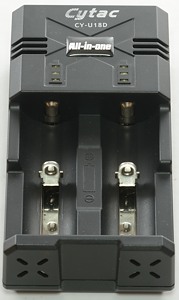
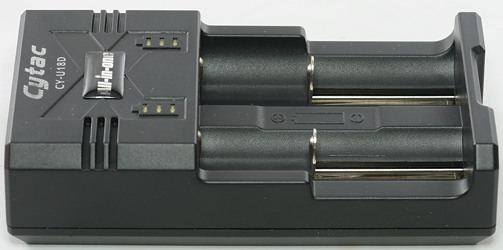
This charger from Cytac is a multi chemistry charger, i.e. it can handle both NiMH and LiIon batteries, the charger current is not that high, this makes it suitable for many battery sizes.
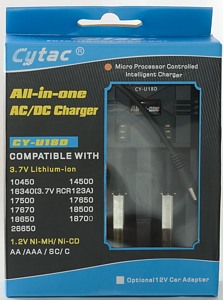

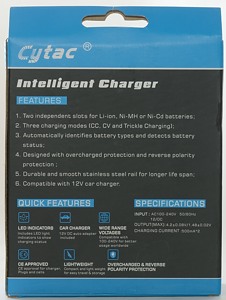

It comes in a cardboard box with a window, on the box is listed all the battery sizes the charger supports.
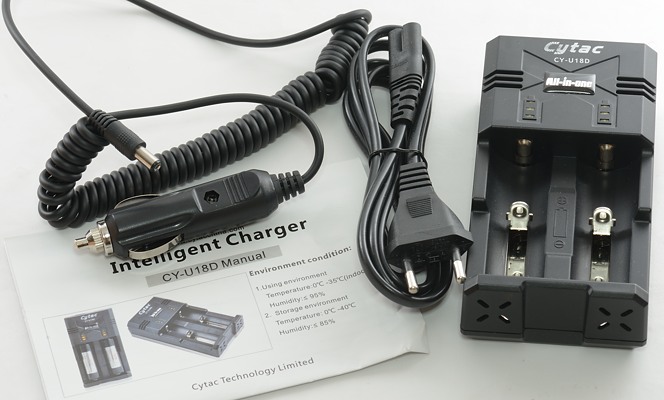
The box contains the charger, a power cord, a car power adapter, a warranty card and a instruction manual. It looks like the car adapter is optional.
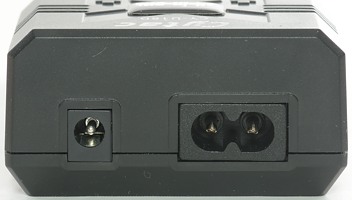
The charger has a standard connection for the power cord and is universal voltage (100-240V 50/60Hz). It does also support 12 volt power. In my tests I have only uses 230 VAC.
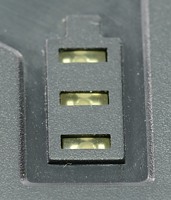
The charger has 3 yellow leds for each battery, they will show the actual charge state when charging:
None: no battery detected
1 flashing, 1 steady + 1 flashing, 2 steady + 1 flashing: Charging, number of leds is a rough guide to actual charge level.
3 steady: Battery is full.
3 flashing: Fail.

The plus connection is slightly raised, this means that the charger can be used with flat top batteries.
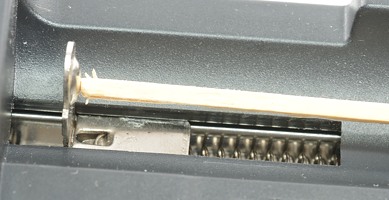
The minus connection is a slider, making it possible to charge different size batteries without using a spacer. The slider is working very smooth. It will handle batteries from 30mm to 70.3mm.
I had no problem with any of the supported battery sizes, they were easy to put into the charger and did always make connection.


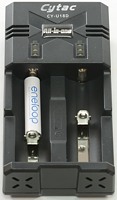
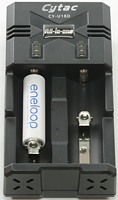


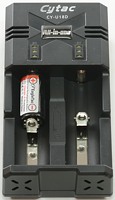
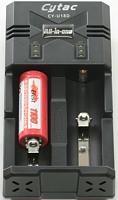
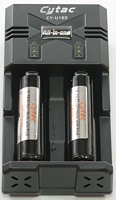
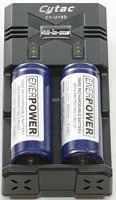
The charger can handle 70 mm long batteries including flat top cells.
The charge current is to high for 10440 batteries and I will not recommend charging them in the charger (It is ok to charger NiMH AAA batteries).
Measurements
- Discharge a battery with up to 1.4mA (0.5mAh for NiMH) when not connected to power.
- Charge battery with 0.3mA (1.2mA for NiMH) with full battery when power is connected.
- Will not restart charging if battery voltage drops.
- The charge will restart when a battery is inserted or power is cycled.
- Below 0.27 volt the battery is assumed faulty and all leds will flash, it is still charging with 1.4mA.
- Up to about 2 volt it assumes NiMH batteries, above that LiIon batteries.
- Two batteries in the charger will not change the charge current, i.e. the channels are truly independent.
- Because each channel is independent, the different voltages and currents vary between the channels with a small amount.
.png)
The charger uses CC/CV charging profile with a termination current around 50mA.
With 0.5A charge current it is not exactly fast to charge 3400mAh batteries, it takes nearly 8 hour on this charger.
.png)
The second channel looks exactly like the first.
.png)
Using both channels at the same time, does not change anything.
.png)
My old IMR cell also charges fine.
.png)
A more recent IMR cells with more capacity does also charge fine.
.png)
.png)
Other capacities, again it takes a lot of time due to the low charge current.
.png)
.png)
NiMH batteries uses another charge algorithm, it looks like it is a constant voltage termination and not the recommended -dv/dt.
.png)
The second channel does again look like the first.
.png)
And using two channels at the same time, does not change the charge time.
%20110VAC.png)
A test with 110VAC does not show any difference. This test was done with two LiIon cells, because they needs the most charging power.
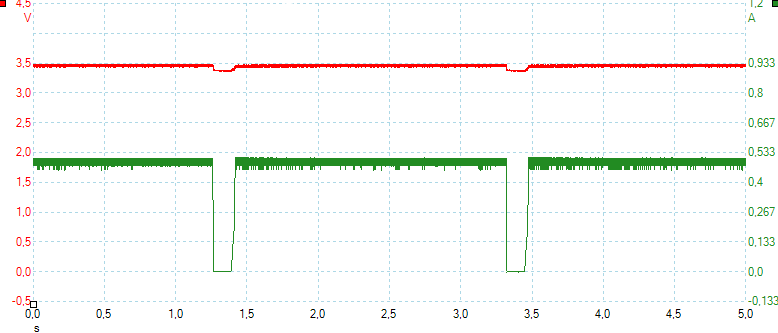
The charging for LiIon is pulsing, there is a short pause each 2 second, probably used to check the voltage.
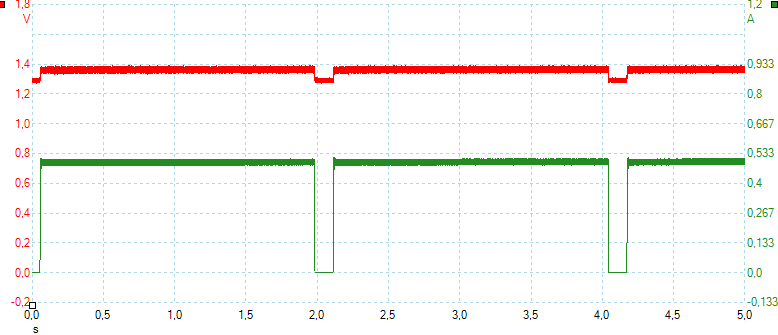
The charging for NiMH is also pulsing, there is a short pause each 2 second, probably used to check the voltage.
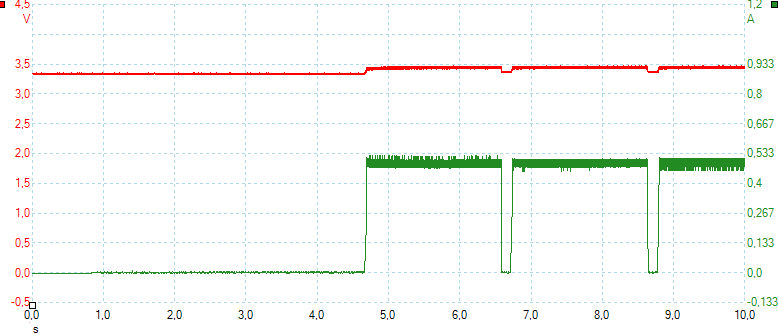
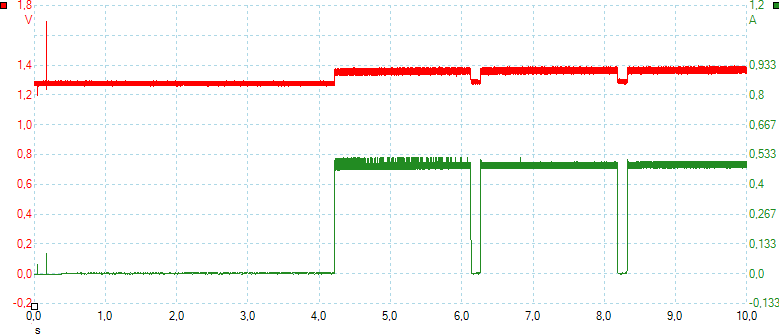
The charger is fast at starting, only about 4 seconds from power on until it is charging.
Testing the mains transformer with 2500 volt and 5000 volt between mains and low volt side, did not show any safety problems.
Conclusion
With the 0.5A charge current and dual chemistry support the charger is suitable for a large range of battery sizes and types. The tray works very good with any size battery. The actual charge algorithms are not perfect, but do work.
This charger is a good multi chemistry charger.
Notes
The charger was supplied by Cytac for review.
This charger is very similar to the Sysmax I2 charger.
Here is an explanation on how I did the above charge curves: How do I test a charger





















.png)
.png)
.png)
.png)
.png)
.png)
.png)
.png)
.png)
.png)
.png)
%20110VAC.png)



